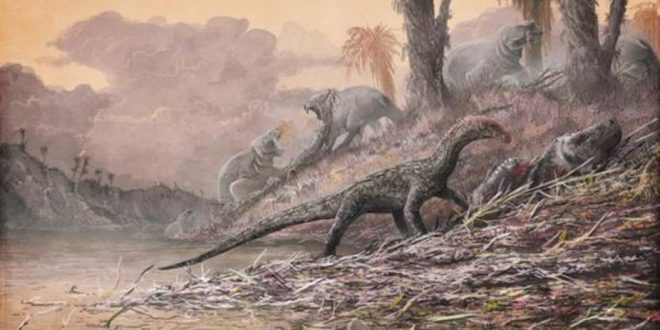A discovery of fossil bones of one of the earliest dinosaur relatives shows a creature that is a mesh of crocodilian and dinosaur-like features.
The discovery of an odd-looking species named Teleocrater rhadinus has filled a gap in the fossil record just before the origin of dinosaurs.
The first dinosaurs roamed the Earth in the late Triassic around 230 million years ago. They dominated the planet up until their mass extinction 65 million years ago. But scientists know little about what came before them.
Dinosaurs and crocodiles share a common ancestor—a large group of reptiles called archosaurs. This group split into two branches; one was a bird branch that led to dinosaurs, the other a crocodile branch from which alligators and crocodiles would emerge.
Scientists had thought that the first pre-dinosaurs were small creatures that walked on two legs, so the discovery of T. rhadinus, which was slow-moving, 7 to 10-feet long and walked on all fours, was a big surprise. The study, published in the journal Nature, means scientists will have to rethink early dinosaur evolution.
Study co-author Richard Butler, from the University of Birmingham, UK, tells Newsweek the relationship between T. rhadinus and dinosaurs is similar to that of great apes and humans. “This is a lineage that split off from the evolutionary lineage that went on toward dinosaurs, so they’re not directly ancestral but they are close cousins, if you like,” he says.
“What was unusual was that for some time we’ve had fossils of close dinosaur relatives, but a lot of them are very small, maybe pigeon-sized animals. So our classic idea of the closest relatives of dinosaurs (and by influence what dinosaur ancestors were like), has been that they were very small, fast moving bipedal animals. The Teleocrater compared to that is very large.”
T. rhadinus had several features characteristic of dinosaurs. “Teleocrater has very long neck vertebrate—so a very long neck—and this is something we see in the earliest dinosaurs,” Butler says. “It also had a very long flange on the upper arm bone for the attachment of powerful muscles and this is classically something we thought of as dinosaur features. It shows some of these features we thought of as dinosaur characters evolved earlier.”
T. rhadinus also had some of the primitive features we associate with crocodiles, with the bones in its ankle able to rotate from side to side as well as up and down. Dinosaurs and birds can only hinge their ankles in an up-and-down motion. As a result, the researchers believe the species would have had a crocodile-like gait.
Another co-author, Ken Angielczyk, from the Field Museum in Chicago, Illinois, said this mix of features is significant: “Teleocrater shows us that bird-line archosaurs initially inherited many crocodile-like features from the common ancestor of all archosaurs, and that the ‘typical’ bird-line features evolved in a step-wise fashion over a longer period of time,” he said in a statement. “Scientists generally don’t love the term ‘missing link,’ but that’s kind of what Teleocrater is: a missing link between dinosaurs and the common ancestor they share with crocodiles.”
The T. rhadinus fossil was first uncovered in Tanzania the 1930s, but had sat in a museum collection, with palaeontologists unaware of its significance. There is a large collection of fossils made in the same area T. rhadinus was found, and experts are now working through this material to get a better understanding of the ecology at the time.
“We’re starting to get a much better understanding of the ecosystem that this animal would have been living in was like—and what the other animals living alongside it were like. There was a huge diversity of reptiles living alongside Teleocrater,” Butler says.
“We don’t have a huge amount of information on the vegetation, so we’ve been reconstructing a typical ecosystem for this kind of time period. It’s quite dry and arid but there are rivers, as we’ve got the sediments that are being formed in rivers. In terms of vegetation, this is before we have any flowering plants at all. The vegetation that’s going to be around will be things like cycads and early conifers, ferns and horsetails.”
He said the next step will be to publish a full description of the anatomy of T. rhadinus. This will help scientists better position it in the evolutionary tree, and, in turn, provide a far better insight into its evolutionary implications: “It’s the oldest member of this lineage that leads towards dinosaurs, so it tells us a bit more about the timing of when that lineage first appears and begins to diversify to ultimately become dinosaurs,” Butler says.
Agencies/Canadajournal
 Canada Journal – News of the World Articles and videos to bring you the biggest Canadian news stories from across the country every day
Canada Journal – News of the World Articles and videos to bring you the biggest Canadian news stories from across the country every day



